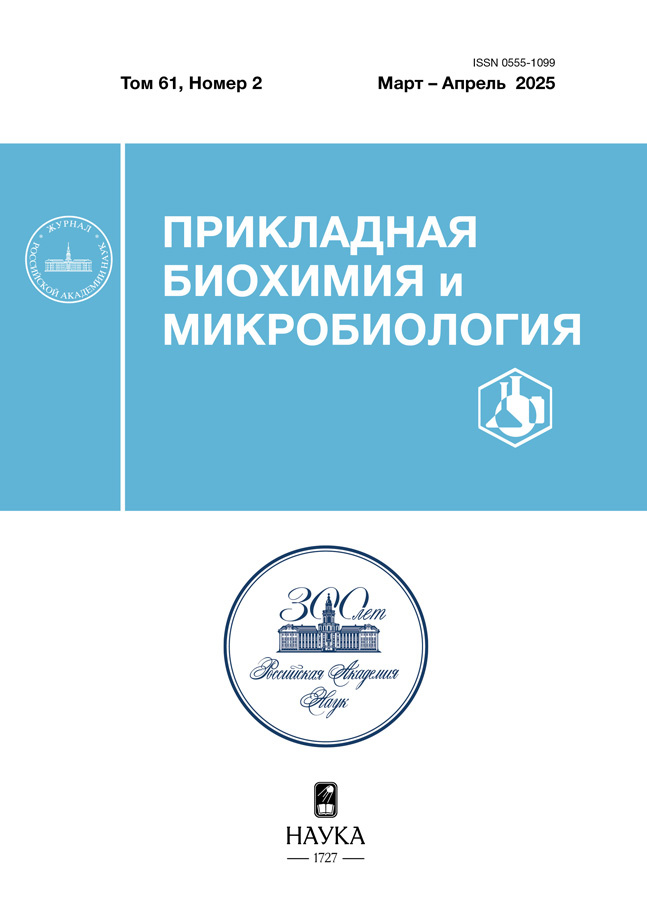Effect of the mineral composition of sulfide raw materials on bioleaching of sulfide minerals
- 作者: Bulaev A.G.1, Muravyov M.I.1, Melamud V.S.1, Fomchenko N.V.1
-
隶属关系:
- Federal Research Centre “Fundamentals of Biotechnology” of the Russian Academy of Sciences
- 期: 卷 61, 编号 2 (2025)
- 页面: 185-193
- 栏目: Articles
- URL: https://archivog.com/0555-1099/article/view/687475
- DOI: https://doi.org/10.31857/S0555109925020087
- EDN: https://elibrary.ru/EOQXGV
- ID: 687475
如何引用文章
详细
Bioleaching of nickel-copper sulfide ore, 2 sulfide copper-nickel concentrates, and copper-zinc concentrate was studied. It was shown that specific rates of nickel leaching were similar in experiments with all studied raw materials. It was 59.3, 58.7, and 54.4 mg/(g·d) in the case of the ore, concentrate 1, and concentrate 2, respectively. Specific rate of zinc leaching from copper-zinc concentrate was 248.6 mg/(g·d). Copper extraction level reached 98.5%, while its content decreased from 7.4% (in the concentrate) to 0.21% (leaching residue). Specific copper leaching rate (7.3–14.8 mg/(g·d)) was lower than those of nickel and zinc. In contrast to nickel and zinc, copper content in bioleaching residue increased in comparison to the concentrate: in the case of copper-nickel concentrates it increased from 15.1 to 17.8% (concentrate 1) and from 19.1 to 19.7% (concentrate 2), while in the case of copper-zinc concentrate, it increased from 10.1 to 16.1%. Thus, bioleaching of all studied concentrates made it possible to obtain copper concentrates with comparatively high copper content (16–19%), which can be commercial products for pyrometallurgy. A comparative analysis of the leaching processes of the selected raw materials will allow to assess the prospects of using the approach under study for processing concentrates and ores of various compositions and with different ratios of non-ferrous metal minerals.
全文:
作者简介
A. Bulaev
Federal Research Centre “Fundamentals of Biotechnology” of the Russian Academy of Sciences
编辑信件的主要联系方式.
Email: bulaev.inmi@yandex.ru
Winogradsky Institute of Microbiology
俄罗斯联邦, Moscow, 119071M. Muravyov
Federal Research Centre “Fundamentals of Biotechnology” of the Russian Academy of Sciences
Email: bulaev.inmi@yandex.ru
Winogradsky Institute of Microbiology
俄罗斯联邦, Moscow, 119071V. Melamud
Federal Research Centre “Fundamentals of Biotechnology” of the Russian Academy of Sciences
Email: bulaev.inmi@yandex.ru
Winogradsky Institute of Microbiology
俄罗斯联邦, Moscow, 119071N. Fomchenko
Federal Research Centre “Fundamentals of Biotechnology” of the Russian Academy of Sciences
Email: bulaev.inmi@yandex.ru
Winogradsky Institute of Microbiology
俄罗斯联邦, Moscow, 119071参考
- Brierley C., Brierley J. // Appl. Microbiol. Biotechnol. 2013. V. 97. № 17. P. 7543–7552. https://doi.org/10.1007/s00253-013-5095-3
- Batty J., Rorke G. // Hydrometallurgy. 2006. V. 83. № 1–4. P. 83–89. https://doi.org/10.1016/j.hydromet.2006.03.049
- Gentina J.C., Acevedo F. // Minerals. 2016. V. 6. № 1. 23. https://doi.org/10.3390/min6010023
- Johnson D. // Minerals. 2018. V. 8. № 8. 343. https://doi.org/10.3390/min8080343
- Fomchenko N., Muravyov M. // Minerals. 2020. V. 10. № 12. 1097. https://doi.org/10.3390/min10121097
- Kaksonen A.H., Lakaniemi A.-M., Tuovinen O.H. // J. Cleaner Prod. 2020. V. 264. 121586. https://doi.org/10.1016/j.jclepro.2020.121586
- Kaksonen A.H., Mudunuru B.M., Hackl R. // Hydrometallurgy. 2014. V. 142. P. 70–83. https://doi.org/10.1016/j.hydromet.2013.11.008
- Mahmoud A., Ceza P., Hoadley A.F.A., Contamin F., D’Hugues P. // Int. Biodeterior. Biodegrad. 2017. V. 119. P. 118–146. https://doi.org/10.1016/j.ibiod.2016.09.015
- Fomchenko N., Muravyov M. // Hydrometallurgy. 2019. V. 185. P. 82–87. https://doi.org/10.1016/j.hydromet.2019.02.002
- Esmailbagi M.R., Schaffie M., Kamyabi A., Ranjbar M. // Hydrometallurgy. 2018. V. 180. P. 139–143. https://doi.org/10.1016/j.hydromet.2018.07.020
- Fomchenko N., Muravyov M. // Appl. Biochem. Microbiol. 2017. V. 53. № 6. P. 715–718. https://doi.org/10.1134/S0003683817060059
- Fomchenko N., Uvarova T., Muravyov M. // Miner. Eng. 2019. V. 138. P. 1–6. https://doi.org/10.1016/j.mineng.2019.04.026
- Watling H.R. // Hydrometallurgy. 2008. V. 91. № 1–4. P. 70–88. https://doi.org/10.1016/j.hydromet.2007.11.012
- Sun J.Z., Wen J.K., Wu B., Chen B.W. // Minerals. 2020. V. 10. № 3. 289. https://doi.org/10.3390/min10030289
- Muravyov M.I., Fomchenko N.V. // Appl. Biochem. Microbiol. 2019. V. 55. № 4. P. 414–419. https://doi.org/10.1134/S0003683819040124
- Muravyov M., Panyushkina A., Bulaev A., Fomchenko N. // Minerals Engineering. 2021. V. 170. 107040. https://doi.org/10.1016/j.mineng.2021.107040
- Muravyov M., Panyushkina A., Fomchenko N. // Journal of Environmental Management. 2022. V. 318. 115587. https://doi.org/10.1016/j.jenvman.2022.115587
- Muravyov M., Panyushkina A. // Hydrometallurgy. 2023. V. 219. 106067. https://doi.org/10.1016/j.hydromet.2023.106067
- Muravyov M., Panyushkina A., Fomchenko N. // Minerals Engineering. 2022. V. 182. 107586. https://doi.org/10.1016/j.mineng.2022.107586
- Муравьёв М.И., Панюшкина А.Е., Меламуд В.С., Булаев А.Г., Фомченко Н.В. // Прикл. биохимия и микробиология. 2021. Т. 57. № 4. С. 380–387. https://doi.org/10.31857/S0555109921040115
- Фомченко Н.В., Панюшкина А.Е., Меламуд В.С., Муравьёв М.И. // Прикл. биохимия и микробиология. 2022. Т. 58. № 4. С. 382–387. https://doi.org/10.31857/S0555109922040043
- Fu K., Ning Y., Chen S., Wang Z. // Mineral Processing and Extractive Metallurgy (Trans. Inst. Min. Metall. C). 2016. V. 125. № 1. P. 1–4. https://doi.org/10.1179/1743285515Y.0000000013
- Zhao H., Wang J., Yang C., Hu M., Gan X., Tao L. et al. // Hydrometallurgy. 2015. V. 151. P. 141–150. https://doi.org/10.1016/j.hydromet.2014.11.009
- Kondrat’eva T.F., Pivovarova T.A., Tsaplina I.A., Fomchenko N.V., Zhuravleva A.E., Murav’ev M.I. et al. // Microbiol. 2012. V. 81. № 1. V. 1–24. https://doi.org/10.1134/S0026261712010080
- Panyushkina A.E., Tsaplina I.A., Kondrat’eva T.F., Belyi A.V., Bulaev A.G. // Microbiol. 2018. V. 87. № 3. P. 326–338. https://doi.org/10.1134/S0026261718030086
- Watling H.R., Collinson D.M., Fjastad S., Kaksonen A.H., Li J., Morris C., Perrot F.A., Rea S.M., Shiers D.W. // Miner. Eng. 2014. V. 58. P. 90–99. https://doi.org/10.1016/j.mineng.2014.01.022
- Mason L.J., Rice N.M. // Miner. Eng. 2002. V. 15. № 11. P. 795–808. https://doi.org/10.1016/S0892-6875(02)00118-8
- Sun J., Wen J., Wu B., Chen B. // Minerals. 2020. V. 10. № 3. 289. https://doi.org/10.3390/min10030289
- Watling H.R. // Hydrometallurgy. 2006. V. 84. № 1–2. P. 81–108. https://doi.org/10.1016/j.hydromet.2006.05.001
- Hedrich S., Joulian C., Graupner T., Schippers A., Guezennec A.G. // Hydrometallurgy. 2018. V. 179. P. 125–131. https://doi.org/10.1016/j.hydromet.2018.05.018
- Silverman M.P., Lundgren D.G. // J. Bacteriol. 1959. V. 77. № 5. P. 642–647. https://doi.org/10.1128/jb.77.5.642-647.1959
- Davis D.G., Jacobsen W.R. // Anal. Chem. 1960. V. 32. № 2. P. 215–217. https://doi.org/10.1021/ac60158a024
- Souza A.D., Pina P.S., Leao V.A., Silva C.A., Siqueira P.F. // Hydrometallurgy. 2007. V. 89. № 1–2. P. 72–81. https://doi.org/10.1016/j.hydromet.2007.05.008
- Wang Y., Chen X., Zhou H. // Biores. Technol. 2018. V. 265. P. 581–585. https://doi.org/10.1016/j.biortech.2018.07.017
- Riekkola-Vanhanen M., Heimala S. // Proceedings of an International Biohydrometallurgy Symposium. 1993. V. 1. P. 561–570.
补充文件















